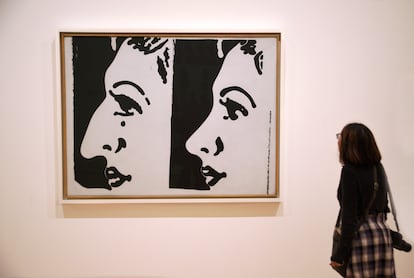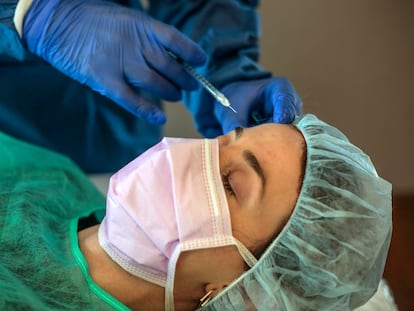‘My wife left me several months after my hair transplant’: How cosmetic surgery affects our relationships
There is a ripple effect when an individual invests in a new nose, bigger breasts or a new head of hair with family and friends forced to adapt to unfamiliar features


Oscar B., a 36-year-old software designer, found his partner Marta’s addiction to cosmetic surgery to be an impossible challenge: “She needed the kind of help that I was never able to give her,” he explains. After two years of dating and four years of marriage, Oscar decided to split from Marta when she announced her intention to undergo breast reduction and a buttock lift, despite recognizing that the latter procedure — known as BBL: Brazilian Butt Lift — is considered high-risk.
As Oscar says, BBL “consists of performing liposuction on the belly, sides and back and then injecting the dead fat into the buttocks using a cannula. Apparently, this is one of the most dangerous cosmetic operations as there is a possibility that the fat could be injected into the gluteal muscle and end up in the lungs or the heart through the network of blood vessels present in the area.”
When Oscar explained to Marta, after reading an article in The New York Times, that two out of every 6,000 buttock lifts result in death, Marta dismissed his concerns: “She said we have to die of something, and that even going out on the street is risky.”
Body dysmorphia
Marta was a lingerie model in her teens but, according to Oscar, even then “she hated her body.” At the age of 20, she began to undergo minor procedures, such as labia collagen injections. Then came Botox, an “unnecessary” rhinoplasty that created complications such as a persistent lack of sensitivity and numbness and, once she turned 30, a breast enlargement, though some years later she would opt to reverse this procedure. There was also a blepharoplasty that caused eye irritation and left her with visible scars: “Marta tolerates all these setbacks as if they were collateral damage for what she sees as a process of self-perfection, her life’s work,” says Oscar. “She feels like a kind of martyr. My only hope is that someone will eventually convince her that she suffers from acute body dysmorphia.”
Oscar acknowledges that some of the interventions had the effect, “in the short term,” of boosting his wife’s self-confidence, and so boosting her appetite for sex. “She needs that periodic injection of self-esteem,” he observes. “But it’s a bottomless pit. The anxiety reappears again and again and she is only able to appease it with more surgery. Meanwhile, my sexual desire was diminishing. Marta is rather petite and her body, in my opinion, has gradually lost its proportions — its natural harmony. As painful as it is to say, it ended up looking grotesque to me.”

Less gruesome but no less troubling is the case of Andres, a 39-year-old accountant who blames a Botox procedure for losing out on “a well-deserved promotion.” Andres was about to be promoted at his waste management company, and decided to celebrate by rejuvenating his appearance with “a minor cosmetic touch-up.” The procedure resulted in an unsightly swelling in the target area which, as he explains, “was very visible when the CEO of the company came to our headquarters to meet the candidates.”
The successful candidate turned out to be a colleague with a discreet background who had not been tipped to win. “Months later, my direct supervisor, the person who was leaving the company and who I was supposed to replace, told me that I had been selected, but the CEO changed his mind because of my physical appearance,” Andres explains. “Apparently, he even went so far as to say that he found my crooked smile repulsive, and that my decision to get Botox injections at such a young age made him think that I was someone who was either too obsessed with my looks or had severe self-confidence issues, which ruled me out for a senior position.”
The latest survey by the International Society of Aesthetic Plastic Surgery (ISAPS) reveals that in 2021 there was a 19.8% global increase in the number of interventions performed by plastic surgeons, reaching 12.8 million surgical and 1.5 million non-surgical procedures.
This means there has been a 215% increase over eight years. Nearly 40% of the global population admit to having resorted to doing something medical to improve their appearance at some point. The gradual decrease in the average age of those who undergo surgery for “touch-ups” is also significant. In 2010, only 22% were under 29. In 2018, this figure had risen to 27.2%. In the last decade, an average of more than 8,000 interventions are being performed annually on people under 18, a consequence of the growing “trivialization” of minor interventions such as the use of facial botulinum toxin and hyaluronic acid injections, according to experts.
The ISAPS’ data puts the United States high on the list of the 10 most popular countries for cosmetic surgery with 4,361,000 interventions. Brazil, Mexico, Germany and Spain are also in the top 10. In terms of accredited professionals in aesthetic and restorative surgery, the U.S. has 7,009, China over 3,000 and that southern retouching powerhouse that is Brazil, 6,393 — the corner of the world where the highest number of operations per inhabitant is performed.

Professionals such as Sergio Fernández, vice-president of the Spanish Society of Aesthetic Medicine (SEME), points to factors such as the proliferation of filters for altering appearance on social networks and elsewhere, especially among the young, to explain our obsession with changing our appearance.
The degree of satisfaction with cosmetic interventions is very high in the case of corrective and restorative surgeries, although it is much more variable in those carried out for purely cosmetic reasons or those related to psychosocial anguish about appearance. Nevertheless, some specialists point to overall satisfaction rates of over 80%, even in delicate interventions that may require long periods of recovery and adaptation regarding the affected area, such as rhinoplasties.
Another question is to what extent the results impact those closest to the patient. In other words, how common are cases such as that of Oscar and his wife Marta?
Altered perceptions
Idoia, a 29-year-old trainee student, also considers herself the collateral damage of other people’s ill-calibrated surgeries. In her case, it was the breast reduction surgery undertaken by her partner, Sandra, 10 years her senior. According to Idoia, Sandra was a voluminous woman, with large breasts, “attractive and self-confident.” Her decision to undergo a reduction mammoplasty had nothing to do with psychosocial anxieties, but rather with the desire to alleviate recurrent back pain caused by the excessive size of her breasts: “Sandra told me that she intended to have surgery and explained her reasons to me shortly after we started living together,” says Idoia. “I was surprised, but I had to admit that it was perfectly logical and I decided to support and accompany her in the process.”
But it didn’t turn out to be that straightforward. The operation consists of making a series of incisions to remove breast tissue, accumulated fat and adjoining skin. In a second stage, the breast, nipple and areola are repositioned in as balanced and aesthetic a way as possible. Then, the operated area is drained and bandaged. “They had explained to us that it was advisable for Sandra to wear a post-operative support garment, to prevent the breasts from shifting, and they also told us that she would have scarring and bruising and would suffer a temporary loss of sensation in the area. All of that happened, but I would say it was more uncomfortable than dramatic.”

The real problem was the “unnatural and certainly not desirable” appearance of Sandra’s breasts once the recovery period was behind her. “I feel very petty saying this, but, as a result of the operation, Sandra lost a lot of her physical appeal for me,” says Idoia. “I couldn’t get used to her new look. I stopped desiring her and we almost completely lost that intense physical connection which, I now realize, was at the core of our relationship, even if there was also complicity and affection.”
It took Idoia about half a year to come to terms with the fact that she had lost interest in Sandra: “I explained it to her as gently as I could, but I guess there is no elegant or empathetic way to say that you have stopped desiring a person because her breasts have shrunk,” she says. “I was on the receiving end of a lot of bitterness. I deserved it, but you can’t always control your feelings and desire. The saddest thing of all is that, towards the end, Sandra was willing to enlarge her breasts again if that would make me stay, but under no circumstances would I subject another person to such an ordeal.”
Meanwhile, Sergio G., a 46-year-old civil servant, was on the receiving end of a similar rejection: “My wife, Noe, left me a few months after the trip I made to Turkey, in spring 2018, to have a hair transplant,” explains Sergio. “One of the problems between us, although by no means the only one, was the extent to which I was mortified by the severe alopecia I have suffered from since I was very young. It is something I started to obsess about, as irrational as it sounds. The Turkish hair transplant gave me hope, but it ended up being a bitter disappointment and, in a way, affected my relationship with Noe.”
Noe ended up leaving Sergio, “not because of my physical appearance or the result of the surgery itself, but because of the profound emotional impact all this was having on me and how difficult I was to live with,” he explains. Sergio is still considering the possibility of undergoing a new hair treatment, “this time, with more realistic expectations and guarantees, without resorting to miracle solutions,” but deep down he suspects that the real solution involves “accepting oneself, which is usually the best way for others to accept you.”
Less dramatic is the case of Daniel, 41, who underwent an otoplasty months ago, in theory a routine procedure, to reposition once and for all the “protruding” ears that had traumatized him since adolescence: “I was happy with the result,” he says. “But a very close friend told me, not in a bad way, that the retouching had altered the balance of my face, detracting from my personality.” Daniel couldn’t help but take his friend’s opinion to heart: “When I looked at myself in the mirror, I thought I understood perfectly well what she meant. My new ears, better positioned and somewhat smaller, didn’t seem to fit my face at all, they were like a foreign body grafted on. Someone else’s ears.” Daniel had the feeling of having made “an irreparable mistake due to absurd complexes.” He let his hair grow and began to comb his hair “in such a way that the ears would always be covered.”
Now, having put the profound psychological effect of his friend’s words behind him, Daniel has found a way to come to terms with his appearance: “I tend to think that my ears were fine the way they were, but there’s nothing wrong with them now either,” he says. “There will always be conflicting opinions, like that of my friend, but I have to get used to accepting them and make sure they don’t affect me if I don’t want to become a scalpel addict or eternally dissatisfied.”
Sign up for our weekly newsletter to get more English-language news coverage from EL PAÍS USA Edition
Tu suscripción se está usando en otro dispositivo
¿Quieres añadir otro usuario a tu suscripción?
Si continúas leyendo en este dispositivo, no se podrá leer en el otro.
FlechaTu suscripción se está usando en otro dispositivo y solo puedes acceder a EL PAÍS desde un dispositivo a la vez.
Si quieres compartir tu cuenta, cambia tu suscripción a la modalidad Premium, así podrás añadir otro usuario. Cada uno accederá con su propia cuenta de email, lo que os permitirá personalizar vuestra experiencia en EL PAÍS.
¿Tienes una suscripción de empresa? Accede aquí para contratar más cuentas.
En el caso de no saber quién está usando tu cuenta, te recomendamos cambiar tu contraseña aquí.
Si decides continuar compartiendo tu cuenta, este mensaje se mostrará en tu dispositivo y en el de la otra persona que está usando tu cuenta de forma indefinida, afectando a tu experiencia de lectura. Puedes consultar aquí los términos y condiciones de la suscripción digital.
More information
Últimas noticias
There is as much life left to discover on planet Earth as that which is already known
Dozens presumed dead, around 100 injured in fire at Swiss Alps bar during New Year’s celebration
Is porn for women different from conventional porn? We spoke to those who make it
Cartagena de Indias is sinking: What can the city do to mitigate it?
Most viewed
- David King, chemist: ‘There are scientists studying how to cool the planet; nobody should stop these experiments from happening’
- Reinhard Genzel, Nobel laureate in physics: ‘One-minute videos will never give you the truth’
- Oona Chaplin: ‘I told James Cameron that I was living in a treehouse and starting a permaculture project with a friend’
- Sinaloa Cartel war is taking its toll on Los Chapitos
- The Interoceanic Train, the Mexican alternative to the Panama Canal










































